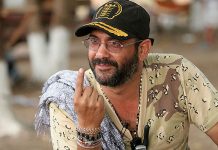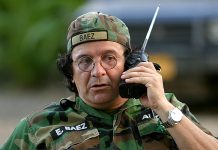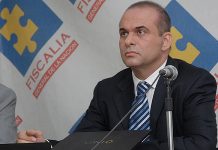Two paramilitary factions, supposedly created to combat guerrillas,
killed each other for control of drug trafficking, oil royalties and
thousands of hectares of land in Casanare in a paranoiac, hellish war
that left thousands of victims – a war still very much kept secret in
Colombia.
In little more than a few months between late 2003 and early 2004,
about 3,000 people, including civilians and combatants were killed in
Casanare, a department in eastern Colombia rich with oilfields across
rolling plains.
According to VerdadAbierta.com, which consisted of analysis of
information that came to light recently during the Peace and Justice
Law process, and interviews with survivors of the war themselves, the
conflict was a chilling war of deceit, paranoia and greed – and even
children paid the ultimate price.
Martin Llanos’ war in los llanos (plains) of Casanare
Very little is known of the war the country in Casanare. There were
several different factions of paramilitaries clashing not only with
FARC rebels, but among themselves.
Many of the paramilitaries who committed crimes in this department
never joined the demobilization ofthe AUC process, and the main
protagonists have either died, or are fugitives from justice.
Drug boss and paramilitary chief Hector Buitrago, alias “Martin
Llanos” refused to demobilize and is still wanted in connection with
crimes attributed to his group. Miguel Arroyave alias ‘Archangel’ was
killed by his own men, and Pedro Oliverio Guerrero Castillo, alias
‘Knife’, also fled.
However, the inhabitants of the plain Casanareño witnessed a
massacre which will be recorded in the recent history of armed
conflict, in which children were killed, and in which hundreds of
civilians and paramilitaries clashed with each other, VerdadAbierto
reported.
It is from testimony from another ex-paramilitary chief that has
brought much information about the war. Daniel Rendón Herrera, alias
‘Don Mario’, said in testimony as part of the Peace and Justice Law
since November 2009, said the man responsible for the war was emerald
trader Victor Carranza.
‘Don Mario’ said Carranza sowed discord between the two former
paramilitary leaders, telling each that the other wanted to kill the
other.
“Carranza spoke with Miguel (Arroyave) on Martin (Llanos), and from
there I realized that he was using Miguel to alienate Martin. I think
he did the same with Martin,” said Don Mario, the former paramilitary
and drug trafficker.
The war was intense, not only for the populations it ravaged, but
also on the pocketbooks of the combating parties. According to ‘Don
Mario,’ within a month the Centaurs Bloc of the AUC spent about US$7
million for the war. On one day of fighting, his men used 100,000
rounds of ammunition at a cost of US$200,000 said the former
paramilitary, who was chief financial officer of that block until
mid-2004.
Another combatant said the war with Llanos made Arroyave distrust
everyone, even his own men. Many were killed on “suspicion” alone.
There are few in this region who dare speak about the massacre. What
is agreed is that for decades the illegal armed groups fought for a
slice of the pie: oil, timber, agriculture, and illicit coca crops.
VerdadAbierta.com spoke to witnesses of the war, demobilized
combatants, government officials and relatives of the fighters, “and
rebuilt this chapter of paramilitary history, which stained with blood
these rich lands.”
Casanare: A war story
The war in Casanare began about mid-1986, when Hector Buitrago,
organized a paramilitary group known in the region as “the
Buitragueños” to fight guerrillas. The group landed in Casanare, Meta
and part of Ariari subregion, which irked Pirabán Manuel de Jesus, aka
‘Pirate’, and Pedro Oliverio Guerrero, alias “Cuchillo” of the Centaurs
Bloc.
One villager knowledgeable of the Buitragueños expansion, said that
Buitrago joined with the Ramirez and Feliciano families, both owners of
large tracts of land, began setting up cocaine processing labs in
Monterrey and Tauramena Aguazul. But they also began murdering people
by the. At that time cattle ranchers, large supporters of the AUC for
protection of their grazing lands, gave the paramilitaries ranches from
which to mount military operations.
But more than engage in counterinsurgency against the guerrillas,
the Buitrago fighters intimidated and forced entire villages complicit
to cover up drug trafficking activities.
“They collected people in the parks, locked down students in their
classes, and told people not to leave their houses because of alleged
danger and subversive guerrilla activity, but the fact is they wanted
people ‘locked away’ so they wouldn’t see truckloads loaded with
paramilitaries or with chemicals to process cocaine. It was all a big
lie because the guerrilla presence wasn’t seen in Monterrey,” said a
former Casanare municipal official.
The Buitragueños did not limit themselves to fabricating guerrilla
threats. After 1995 they began a systematic campaign to seize land with
oil fields or to evict farmers from areas in exploration areas.
“From Monterrey to Tauramena and Aguazul, they came to farms and
cattle ranches, once with scripture references and names of others.
‘Sign or die’, they said to landowners regarding deeds and titles.
Threats, or worse, were also offered to girls who did not succumb to
advances. they were raped or banished if they did not sleep with
them,”says a person who lived in the area.
At the time, the prosecution and the judges of Villavicencio
launched a conspiracy investigation against Buitrago, resulting in his
incarceration. He later escaped from prison.
While Martin Llanos (Buitrago) consolidated power in the south and
the north of Casanare with the Autodefensas Campesinas del Casanare
(ACC), paramilitaries aligned with Carlos Castaño began to move into
part of the Guaviare, Meta, Casanare and Araca.
Castaño, a founder and former leader of the AUC who was later killed
by his own men, along with Salvatore Mancuso and supported by members
of the security forces came to the Casanare with members of the
Autodefensas Campesinas de Córdoba y Urabá (ACCU) and killed over 50
people near Meta in 1997.
The slaughter was supported by the Self-Defense of Casanare. But
soon a feud developed between the Martin Llanos group and the Casanare
paramilitaries. This was deepened with the slaughter of 11 members of a
judicial commission who were investigating a land dispute in October
1997.
The massacre, ordered by Martin Llanos offended Carlos Castaño.
By this time, Castaño forces pushed into Casanare and Arauca, and clashes resulted with FARC and ELN guerrillas.
The arrival of Castano’s men also produced divisions within the ACC
amongst its southern and northern factions, the latter commanded by
Luis Eduardo Ramirez Vargas, alias ‘HK’, who was later killed by police
in Bogotá in December 2005.
With Castanos entrance into the area, Llanos began to feel threatened.
Ex fighters said Martín Llanos began to step up extortion, kill
farmers to seize land, and exert political pressure remain in control
of Casanare.
“Llanos was going crazy. He did not allow anyone to within 30 feet
of him, and if he suspected someone would turn him, they would be
tortured and later assassinated. Several youths were killed and
returned to their families in black plastic bags. Dozens of his men
were executed like this in Puerto Lopez, on mere suspicion,” said
residents of Puerto Lopez, who saw the corpses.
Llanos’ paranoia drove him to kill people close to him, such as
Victor Feliciano Alfonso along with his wife Martha Nelly Chavez, and
Juan Manuel Feliciano Chaves and four others in February, 2000. Only
Victor Francisco Feliciano was left alive, who denied family ties to
drug trafficking.
Llanos began to lose control of the northern department, especially Yopal, where the population was caught in the midst of war.
An all-out war without truce ensued in April, 2001 which drew about
15,000 people out to protest about the lapse in security. That day
traders, farmers, civilians and politicians shook their fear and called
for and end to violence under banners saying: “Our silence is filling
the graves of the plains of Casanareño.
The fighting intensified and to the point that 10 people per week
were killed. However the police recorded that, in the first quarter of
2001, there were only 85 murders. Official statistics showed deep
differences with the reports of the Ombudsman, according to whom,
between 1997 and the first three months of 2001, there were 31
massacres, of which 12 were in Yopal during the first months of 2001.
In 2001, 2,404 farmers were displaced. Still, authorities described Casanare as “a haven of peace.”
In April 2001 Llanos also called forced meetings of ordinary
citizens,from taxi drivers to teachers, to use them for his own gains.
In one meeting 200 teachers arrived near Monterey, where the
paramilitary leader declared: “Those who vote for the Democratic
candidate or for Horacio Serpa, should assume the consequences,” said a
teacher who attended the meeting and is now a refugee in Villavicencio.
“He came in a small helicopter they called the wasp, greeted former
classmates of the Normal Joint Monterrey, recalled days as students and
even became remorseful. He made a speech about 15 minutes and turned
then left,”said the teacher.
Amid this backdrop, Miguel Arroyave shared the Centaurs Bloc with
Carlos and Vicente Castaño in early 2002, the same time that Miguel
Angel and Victor Manuel Mejia Munera, shared power in the Arauca
Vencedores Bloc, organizations, inevitably forming an alliance against
“Martin Llanos” in Meta, Casanare and Arauca.
The beginning of the end
While ‘Llanos’ opened war fronts throughout his zones of influence,
in Mapiripán his men began feeling the pinch that paramilitaries were
lauanching by Castano’s men.
However, Castano’s forces did not know the terrain and at first took a beating by Martin Llanos’men.
Videos circulating in Monterrey, recorded by members of the Acc in
the area, gave accounts of the fighting between the two sides in rural
areas of Mapiripan.
The images revealed decaying bodies, abandoned military equipment
and machine gun crossfire between ragtag groups of terrified youths of
African descent, in panicked flight, not knowing where to go. To
‘Llanos’ this hollow victory and a omen of what was to come later.
After the initial defeat, Castano sent reinforcements of the
Centaurs, Central Bolívar (BCB) and St. Martin blocs, which very
quickly showed numerical superiority.
Then, the fighting increased in cruelty. Llanos’ forces were reduced
to 300. After cornering Llanos’ forces, Castano’s men pushed north of
Casanare.
According to some Monterrey survivors, the Colombian Air Force
participated in some battles in the form of bombing raids. According to
testimony from a former commander of Centaurs, this came about because
Miguel Arroyave asked senior air force officer to help stop Llanos.
Surrounded by his enemies and demoralized, “Martin Llanos” dug in
near El Tropezón, a few miles from Puerto Lopez. From there his forces
moved until the air force bombings.
With few men, Llanos began recruitment in the capital districts of
Ciudad Bolivar, Soacha, Kennedy, Bosa and Suba. Also in the Morichal
district of Villavicencio, where they took by force 30 children.
“Many people had to leave the sidewalks Caribayona and El Pinal,
because they tricked or forced children as young as 12 years into the
ranks,” complained the mother of one of those children, who
laterrescued him from the mountains and fled to another city.
Many a teenager came to know the horrors inside the ACC
“Those caught crying were killed in front of others. And if someone
fell asleep on watch, a worse fate fell upon them,” said the family of
another minor who was arrested during a military action and sent to the
reform institution Bienestar Familiar.
Skirmishes lasted until early 2004, which was definitive for the two
paramilitary factions. One of those battles began in February and
lasted for five days at the site known as Caribayona, near the
municipality of Villanueva.
During those days more than 140 paramilitaries from both sides were
killed in the fighting and about 20 farmer soldiers were killed near
Villanueva during Arroyave’s retreat to rural Upía Canyon.
But there was stillmore to happen in this absurd anddelusional war:
“In the combat zone, superiors asked their troops, some of them
children, if they were tired. If they responded affirmatively, they
were shot. So were the wounded who arrived in Puerto Lopez and
Monterrey. They asked the nurses which paramilitaries had serious
wounds. They were rounded up in a single place and then a fighter would
toss in a grenade, or they were simply shot,” an eyewitnesses told
VerdadAbierta.com.
The fighting continued sporadically in the savannas between Villanueva, Monterrey and Tauramena.
“At that time the Urabeños (Castanos men) retook the at the same
time as the fighters loyal to Martín Llanos, whom many said had surely
made a pact with the devil. Prisoners were shoved a corral, were given
only one meal a day, and every week one was beheaded. They were guys
who painted their nails black and lined up to drink the blood of the
victims,” said another woman whose daughter, lived for a time with one
Llanos’ men.
In July, 2004 the war did not stop. While the army secured El
Tropezón and captured ACC fighters, on the outskirts of Monterrey, the
crows became fat on those who fell in battle.
In a single day in Puerto Lopez 30 child soldiers died and in
Tauramena 20 others were killed during fighting near La Candelaria.
Their bodies were pulled by tractors and cast into the river Metada
with their stomachs cut open so they would sink.
Fighting led to displacement in Las Delicias, El Yari, El Retorno,
El Tranquero, and almost everywhere that the forces of Llanos and
Castano met. About 30,000 people were forced to leave La Tronca de la
Selva, Many protested because the Army did nothing against Miguel
Arroyave’s overwhelming war machine.
When the end was near, Martín Llanos took refuge with a guard of 10
men and 70 children — recruited in Bogotá, Villavicencio and the region
— who were used as human shields to cover the paramilitary leader’s
flighr to flee.
Days later, on 26 September, the government said in a statement that
the 79 men of the ACC were killed. Many of the fighters surrendered and
others were captured, while Llanos, wounded, fled to Ecuador. He then
moved to Brazil and later to the border between Colombia and Venezuela,
where he still sends threats and warnings of revenge to enemies in
Monterrey.
Although hundreds of paramilitary units of the Casanare Centaurs
demobilized, there is a legend in the region that Martin Llanos’ shadow
lurks among the plains, waiting to regain political and military power,
while at the same time asking for inclusion in Justice and Peace Law.
A shadow that lingers still, sowing terror throughout the plains of Casanare.
Traducido por Colombia Reports











